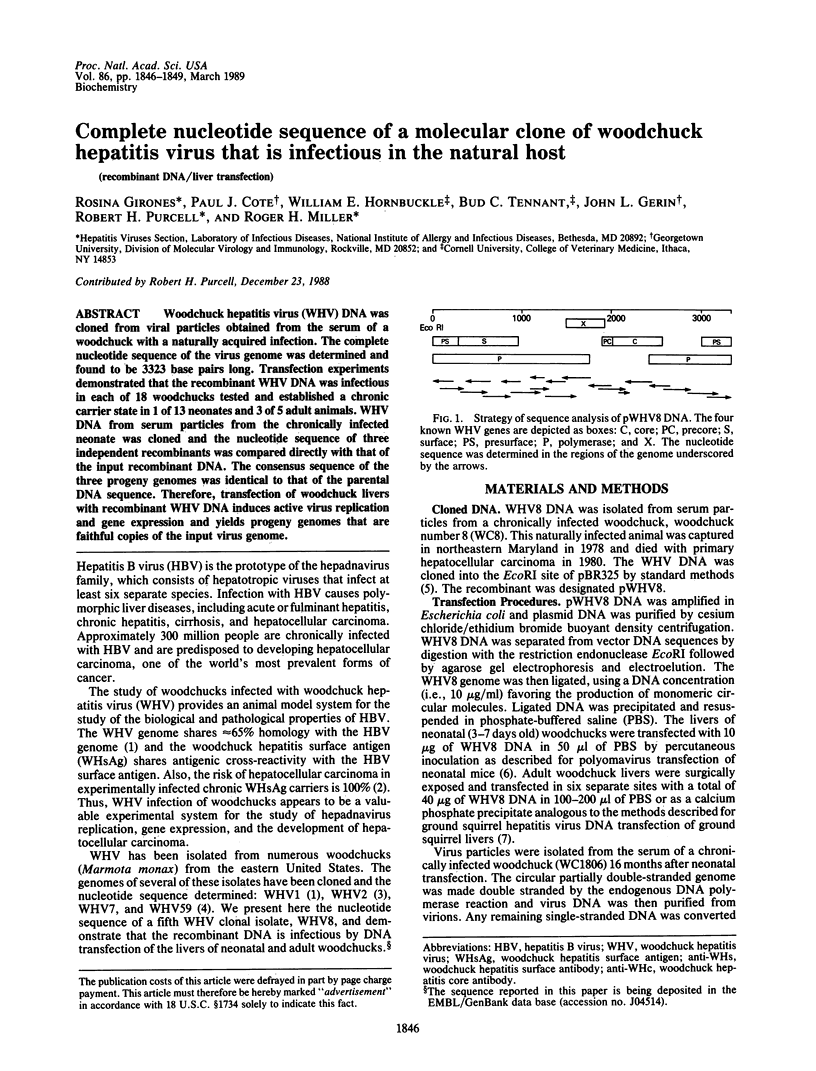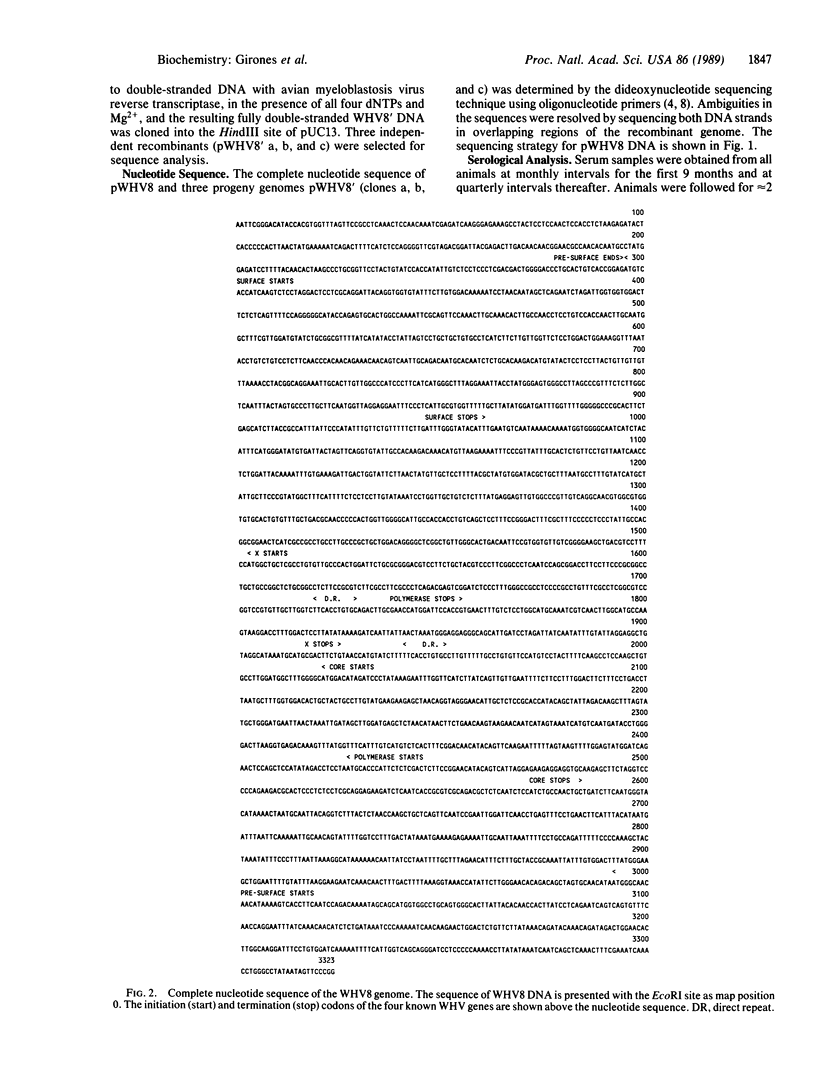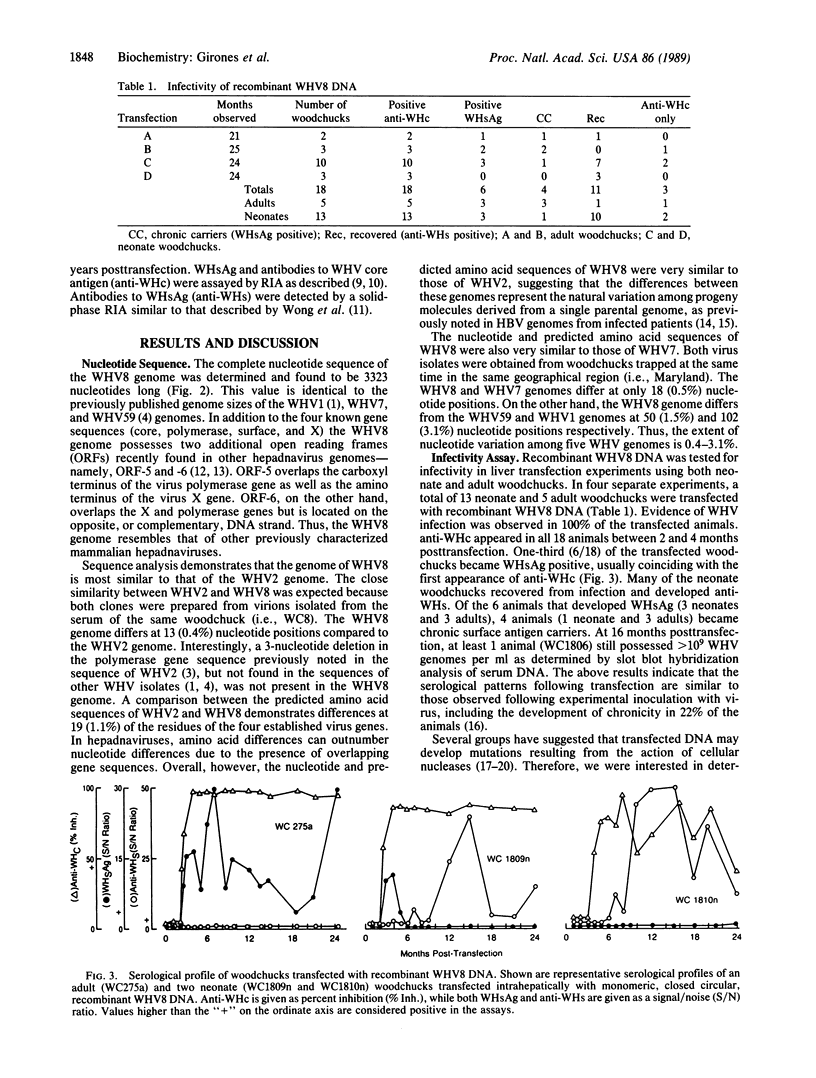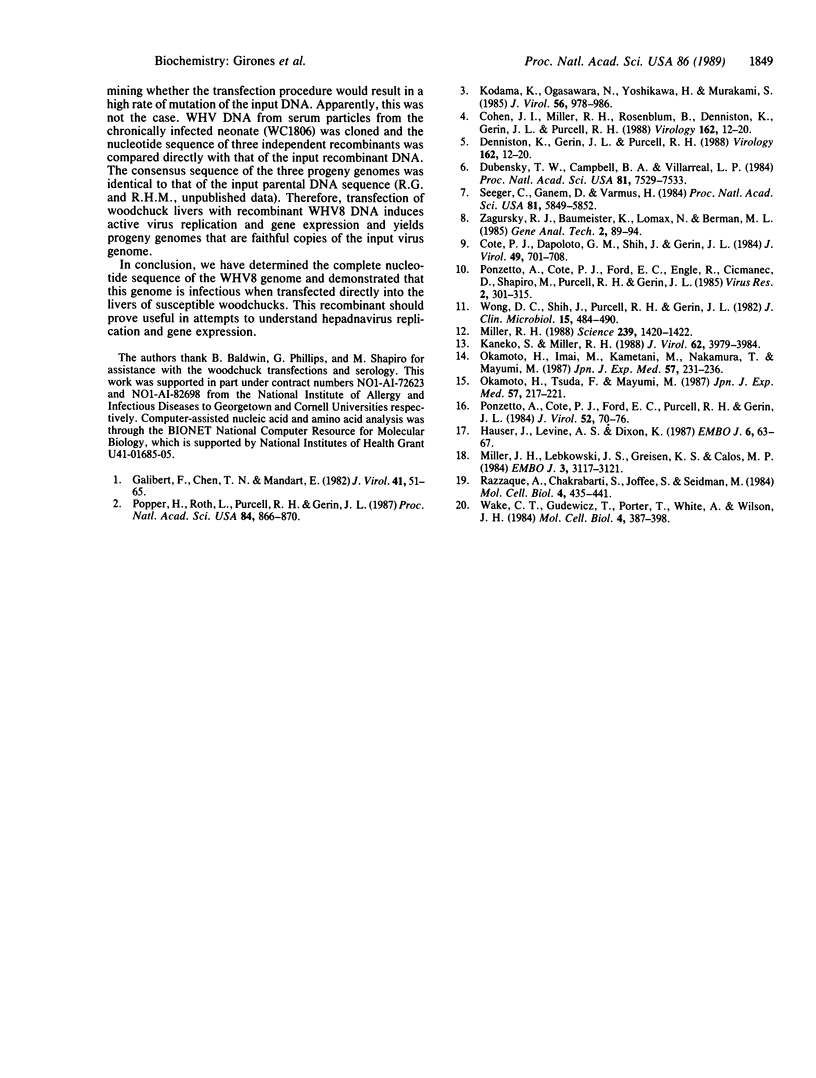Abstract
Woodchuck hepatitis virus (WHV) DNA was cloned from viral particles obtained from the serum of a woodchuck with a naturally acquired infection. The complete nucleotide sequence of the virus genome was determined and found to be 3323 base pairs long. Transfection experiments demonstrated that the recombinant WHV DNA was infectious in each of 18 woodchucks tested and established a chronic carrier state in 1 of 13 neonates and 3 of 5 adult animals. WHV DNA from serum particles from the chronically infected neonate was cloned and the nucleotide sequence of three independent recombinants was compared directly with that of the input recombinant DNA. The consensus sequence of the three progeny genomes was identical to that of the parental DNA sequence. Therefore, transfection of woodchuck livers with recombinant WHV DNA induces active virus replication and gene expression and yields progeny genomes that are faithful copies of the input virus genome.
Full text
PDF



Selected References
These references are in PubMed. This may not be the complete list of references from this article.
- Cohen J. I., Miller R. H., Rosenblum B., Denniston K., Gerin J. L., Purcell R. H. Sequence comparison of woodchuck hepatitis virus replicative forms shows conservation of the genome. Virology. 1988 Jan;162(1):12–20. doi: 10.1016/0042-6822(88)90389-3. [DOI] [PubMed] [Google Scholar]
- Cote P. J., Engle R. E., Langer C. A., Ponzetto A., Gerin J. L. Antigenic analysis of woodchuck hepatitis virus surface antigen with site-specific radioimmunoassays. J Virol. 1984 Mar;49(3):701–708. doi: 10.1128/jvi.49.3.701-708.1984. [DOI] [PMC free article] [PubMed] [Google Scholar]
- Dubensky T. W., Campbell B. A., Villarreal L. P. Direct transfection of viral and plasmid DNA into the liver or spleen of mice. Proc Natl Acad Sci U S A. 1984 Dec;81(23):7529–7533. doi: 10.1073/pnas.81.23.7529. [DOI] [PMC free article] [PubMed] [Google Scholar]
- Galibert F., Chen T. N., Mandart E. Nucleotide sequence of a cloned woodchuck hepatitis virus genome: comparison with the hepatitis B virus sequence. J Virol. 1982 Jan;41(1):51–65. doi: 10.1128/jvi.41.1.51-65.1982. [DOI] [PMC free article] [PubMed] [Google Scholar]
- Hauser J., Levine A. S., Dixon K. Unique pattern of point mutations arising after gene transfer into mammalian cells. EMBO J. 1987 Jan;6(1):63–67. doi: 10.1002/j.1460-2075.1987.tb04719.x. [DOI] [PMC free article] [PubMed] [Google Scholar]
- Kaneko S., Miller R. H. X-region-specific transcript in mammalian hepatitis B virus-infected liver. J Virol. 1988 Nov;62(11):3979–3984. doi: 10.1128/jvi.62.11.3979-3984.1988. [DOI] [PMC free article] [PubMed] [Google Scholar]
- Kodama K., Ogasawara N., Yoshikawa H., Murakami S. Nucleotide sequence of a cloned woodchuck hepatitis virus genome: evolutional relationship between hepadnaviruses. J Virol. 1985 Dec;56(3):978–986. doi: 10.1128/jvi.56.3.978-986.1985. [DOI] [PMC free article] [PubMed] [Google Scholar]
- Miller J. H., Lebkowski J. S., Greisen K. S., Calos M. P. Specificity of mutations induced in transfected DNA by mammalian cells. EMBO J. 1984 Dec 20;3(13):3117–3121. doi: 10.1002/j.1460-2075.1984.tb02267.x. [DOI] [PMC free article] [PubMed] [Google Scholar]
- Miller R. H. Human immunodeficiency virus may encode a novel protein on the genomic DNA plus strand. Science. 1988 Mar 18;239(4846):1420–1422. doi: 10.1126/science.3347840. [DOI] [PubMed] [Google Scholar]
- Okamoto H., Imai M., Kametani M., Nakamura T., Mayumi M. Genomic heterogeneity of hepatitis B virus in a 54-year-old woman who contracted the infection through materno-fetal transmission. Jpn J Exp Med. 1987 Aug;57(4):231–236. [PubMed] [Google Scholar]
- Okamoto H., Tsuda F., Mayumi M. Defective mutants of hepatitis B virus in the circulation of symptom-free carriers. Jpn J Exp Med. 1987 Aug;57(4):217–221. [PubMed] [Google Scholar]
- Ponzetto A., Cote P. J., Ford E. C., Engle R., Cicmanec J., Shapiro M., Purcell R. H., Gerin J. L. Radioimmunoassay and characterization of woodchuck hepatitis virus core antigen and antibody. Virus Res. 1985 Jun;2(4):301–315. doi: 10.1016/0168-1702(85)90027-9. [DOI] [PubMed] [Google Scholar]
- Ponzetto A., Cote P. J., Ford E. C., Purcell R. H., Gerin J. L. Core antigen and antibody in woodchucks after infection with woodchuck hepatitis virus. J Virol. 1984 Oct;52(1):70–76. doi: 10.1128/jvi.52.1.70-76.1984. [DOI] [PMC free article] [PubMed] [Google Scholar]
- Popper H., Roth L., Purcell R. H., Tennant B. C., Gerin J. L. Hepatocarcinogenicity of the woodchuck hepatitis virus. Proc Natl Acad Sci U S A. 1987 Feb;84(3):866–870. doi: 10.1073/pnas.84.3.866. [DOI] [PMC free article] [PubMed] [Google Scholar]
- Razzaque A., Chakrabarti S., Joffee S., Seidman M. Mutagenesis of a shuttle vector plasmid in mammalian cells. Mol Cell Biol. 1984 Mar;4(3):435–441. doi: 10.1128/mcb.4.3.435. [DOI] [PMC free article] [PubMed] [Google Scholar]
- Seeger C., Ganem D., Varmus H. E. The cloned genome of ground squirrel hepatitis virus is infectious in the animal. Proc Natl Acad Sci U S A. 1984 Sep;81(18):5849–5852. doi: 10.1073/pnas.81.18.5849. [DOI] [PMC free article] [PubMed] [Google Scholar]
- Wake C. T., Gudewicz T., Porter T., White A., Wilson J. H. How damaged is the biologically active subpopulation of transfected DNA? Mol Cell Biol. 1984 Mar;4(3):387–398. doi: 10.1128/mcb.4.3.387. [DOI] [PMC free article] [PubMed] [Google Scholar]
- Wong D. C., Shih J. W., Purcell R. H., Gerin J. L., London W. T. Natural and experimental infection of woodchucks with woodchuck hepatitis virus, as measured by new, specific assays for woodchuck surface antigen and antibody. J Clin Microbiol. 1982 Mar;15(3):484–490. doi: 10.1128/jcm.15.3.484-490.1982. [DOI] [PMC free article] [PubMed] [Google Scholar]


